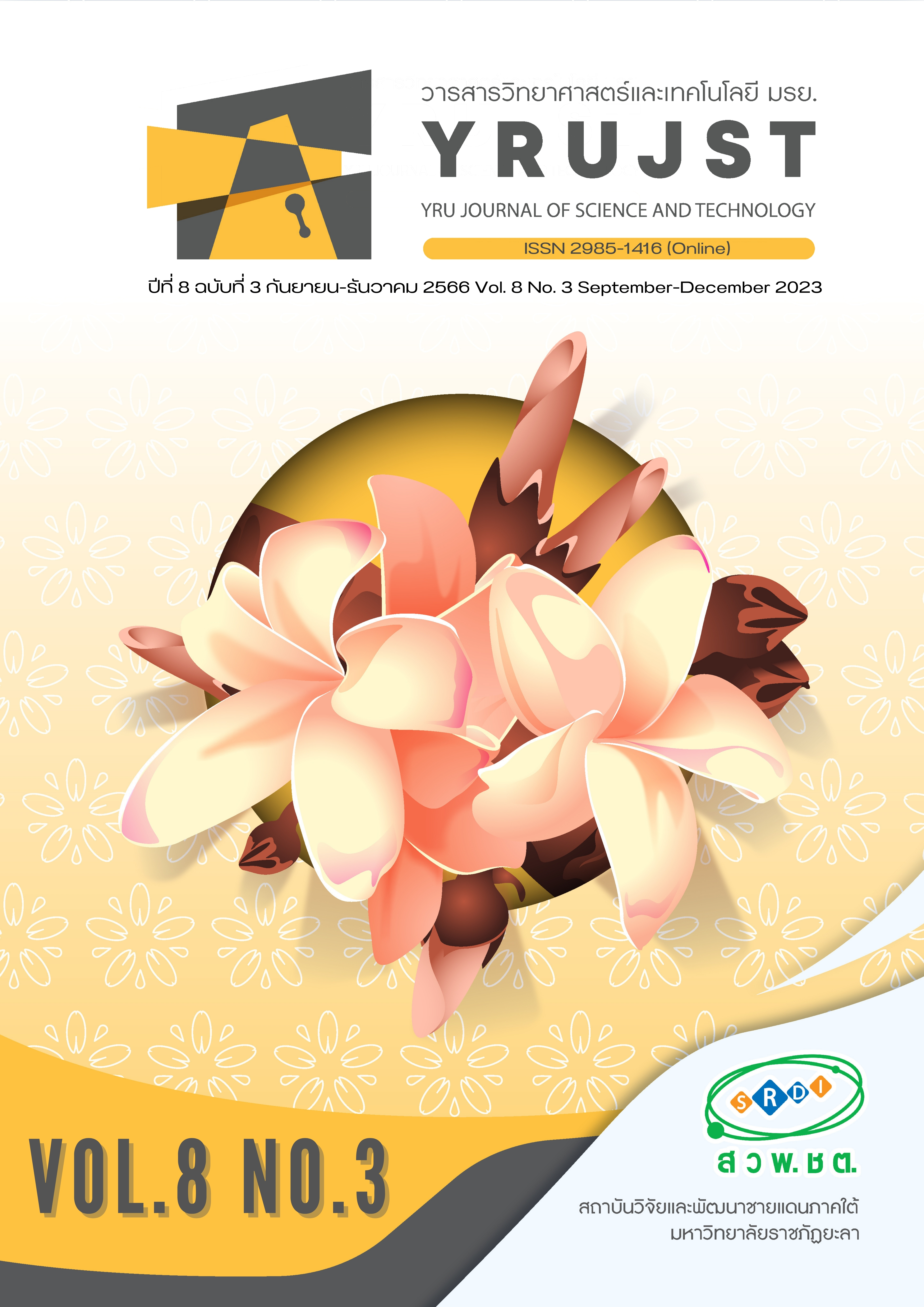การแยกและคัดเลือกแบคทีเรียกรดแลคติกจากอาหารหมักและการประยุกต์ใช้ในการผลิตปุ๋ยหมักน้ำ เพื่อส่งเสริมการเจริญเติบโตของพืช
Main Article Content
บทคัดย่อ
ปุ๋ยหมักน้ำมีส่วนประกอบสำคัญเป็นจุลินทรีย์เช่นแบคทีเรียกรดแลคติกซึ่งช่วยย่อยสลายวัสดุอินทรีย์ให้กลายเป็นสารที่มีประโยชน์ต่อพืช ดังนั้นงานวิจัยนี้จึงมีวัตถุประสงค์เพื่อแยกและคัดเลือกแบคทีเรียกรดแลคติกจากอาหารหมักรวมถึงศึกษาลักษณะและประสิทธิภาพของปุ๋ยหมักน้ำจากแบคทีเรียกรดแลคติกในการส่งเสริมการเจริญเติบโตของผักบุ้ง จากการแยกแบคทีเรียกรดแลคติกจากอาหารหมักพบว่า สามารถแยกแบคทีเรียกรดแลคติกได้ 9 ไอโซเลท (PB1-5 และ PS6-9) โดย PS6 และ PS8 เป็นเชื้อที่สามารถย่อยแป้งและโปรตีนได้ดีที่สุด ดังนั้นจึงเลือกมาใช้ในการผลิตปุ๋ยหมักน้ำ และจากการผลิตปุ๋ยหมักน้ำจำนวน 8 สูตรที่มีส่วนประกอบของแบคทีเรียกรดแลคติกและสารเร่งซุปเปอร์ พด.2 ในอัตราส่วนที่แตกต่างกันพบว่า ในระหว่างการหมักปุ๋ยหมักน้ำมีลักษณะเป็นสีน้ำตาล pH 3.89-6.00 กลิ่นปกติ ไม่เหม็นเน่า จำนวนแบคทีเรียทั้งหมดและแบคทีเรียกรดแลคติก อยู่ระหว่าง 0.07×108 – 3.87×109 CFU/ml และ 0.00 – 4.37×108 CFU/ml ตามลำดับ นอกจากนี้จากการศึกษาประสิทธิภาพของปุ๋ยหมักน้ำพบว่า ปุ๋ยสูตร 3 และ 4 ซึ่งมีแบคทีเรียกรดแลคติกแบบชนิดเดียวเป็นส่วนประกอบสามารถกระตุ้นการเจริญเติบโตของผักบุ้งได้ดีทั้งด้านจำนวนใบ ความยาวใบ และความสูงต้น และที่น่าสนใจคือ ปุ๋ยทั้งสองสูตรนี้สามารถเร่งการเจริญเติบโตของผักบุ้งได้ไม่แตกต่างอย่างมีนัยสำคัญทางสถิติ (p≤0.05) กับปุ๋ยสูตร 2 ซึ่งประกอบด้วยสารเร่งซุปเปอร์ พด.2 ดังนั้นจึงแสดงให้เห็นว่า ปุ๋ยหมักน้ำจากแบคทีเรียกรดแลคติกที่คัดแยกได้สามารถส่งเสริมการเจริญของพืชได้ดีและสามารถใช้เพื่อพัฒนาปุ๋ยที่เป็นมิตรกับสิ่งแวดล้อมต่อไปได้
Article Details

อนุญาตภายใต้เงื่อนไข Creative Commons Attribution-NonCommercial-NoDerivatives 4.0 International License.
บทความ ข้อมูล เนื้อหา รูปภาพ ฯลฯ ที่ได้รับการเผยแพร่ในวารสารวิทยาศาสตร์และเทคโนโลยี มรย. นี้ ถือเป็นลิขสิทธิ์ของวารสารวิทยาศาสตร์และเทคโนโลยี มรย. หากบุคคลหรือหน่วยงานใดต้องการนำทั้งหมดหรือส่วนหนึ่งส่วนใดไปเผยแพร่ต่อหรือกระทำการใดๆ จะต้องได้รับอนุญาตเป็นลายลักษณ์อักษรจากวารสารวิทยาศาสตร์และเทคโนโลยี มรย. ก่อนเท่านั้น
เอกสารอ้างอิง
Atieno, M., Herrmann, L., Nguyen, H. T., Phan, H. T., Nguyen, N. K., Srean, P., et al., (2020). Assessment of biofertilizer use for sustainable agriculture in the Great Mekong Region. Journal of Environmental Management, 275, 111300; https://doi.org/10.1016/j.jenvman.2020.111300.
Chaleoisap, S., Gongseng, S. & Lertcanawanichaku, M. (2011). Antimicrobial activity of lactic acid bacteria isolated from foods and Lactobacillus plantarum strain improvement for using as probiotic. Thaksin University Journal, 14(3), 10-18. (in Thai)
Chanchay, N., Boonkerd, S. & Phukkarawek, Y. (2017). Study and development of pickled starter for producing of biologically fermented plant for consumption. Journal of Srinakharinwirot University (Journal of Science and Technology), 9(17), 26-40. (in Thai)
Chankaweekul, K. & Rangseesuriyachai, T. (2020). Co –composting production from elephant fodder with elephant dung and fermented slurry using anaerobic digestion. The 25th National Convention on Civil Engineering, July 15-17, 2020. Chonburi: The Engineering Institute of Thailand Under H.M. The King’s Patronage. (in Thai)
Chooklin, S. C., Sawain, A. & Krualee, S. (2022). Effect of fermented bio-extract from fish residues by Lactobacillus casei on growth and yield of Brassica campestris var. chinensis. RMUTSV Research Journal, 14(1), 253-265. (in Thai)
Gavrilova, E., Anisimova, E., Gabdelkhadieva, A., Nikitina, E., Vafina, A., Yarullina, D., et al., (2019). Newly isolated lactic acid bacteria from silage targeting biofilms of foodborne pathogens during milk fermentation. BMC Microbiology, 19(1), 1-12.
Jaffar, N. S., Jawan, R. & Chong, K. P. (2023). The potential of lactic acid bacteria in mediating the control of plant diseases and plant growth stimulation in crop production-A mini review. Frontiers in plant science, 13, 1047945; DOI: 10.3389/fpls.2022.1047945. PMID: 36714743; PMCID: PMC9880282.
Khalid, K. (2011). An overview of lactic acid bacteria. International Journal of Biosciences, 1(3), 1-13.
Lamont, J. R., Wilkins, O., Bywater-Ekegärd, M. & Smith, D. L. (2017). From yogurt to yield: Potential applications of lactic acid bacteria in plant production. Soil Biology and Biochemistry, 111, 1-9.
Land development department. (2007). Microbial activator (PD.2) [Online]. Retrieved January 3, 2022,
from: http://slbkb.psu.ac.th/jspui/bitstream/2558/1246/1/010027-2550.pdf. (in Thai)
Linares-Morales, J. R., Cuellar-Nevárez, G. E., Rivera-Chavira, B. E., Gutiérrez-Méndez, N., Pérez-Vega, S. B. & Nevárez-Moorillón, G. V. (2020). Selection of lactic acid bacteria isolated from fresh fruits and vegetables based on their antimicrobial and enzymatic activities. Foods, 9(10), 1399.
Nimrat, S., Sae-Kow, W. & Vuthiphandchai, V., (2021). Survey on quality of commercial probiotic products used for marine culture of ornamental fish. Wichcha Journal Nakhon Si Thammarat Rajabhat University, 40(1), 31-45. (in Thai)
Nosheen, S., Ajmal, I., & Song, Y. (2021). Microbes as biofertilizers, a potential approach for sustainable crop production. Sustainability, 13(4), 1868.
Petnuan, N.,Tilaruk, P.,Anartngam,P. & Suwanposri, A. (2020). Biofertilizer from plant probiotic microorganisms. Agriculture and Technology Journal, 1(2), 12-21. (in Thai)
Prisillia, R. M. A., Susilowati, A., & Solichatun, S. (2021). Screening of phosphate solubilizing bacteria from sugarcane plant rhizosphere as biofertilizer agent for sorghum growth (Sorghum bicolor). Asian Journal of Tropical Biotechnology, 18(1), 37-45.
Raman, J., Kim, J. S., Choi, K. R., Eun, H., Yang, D., Ko, Y. J., et al., (2022). Application of lactic acid bacteria (LAB) in sustainable agriculture: Advantages and limitations. International Journal of Molecular Sciences, 23(14), 7784; https://doi.org/10.3390/ijms23147784.
Rattanachak, N., Nualsri, C., Srisayam, M., Urtgam, S. & Chodnakarin, A. (2020). Solation and probiotic properties of lactic acid bacteria isolated from raw banana (Musa sapientum L.) in Phitsanulok province. Journal of Science and Technology Ubon Ratchathani University, 22(2), 50-57. (in Thai)
Sharma, N., Yadav, N., Bhagwani, H., Chahar, D. & Singh, B. (2018). Screening of lactic acid bacteria from effluent samples of Jaipur dairy. International Journal of Waste Resources, 8(2), 332; DOI: 10.4172/2252-5211.1000332.
Tayuan, C., Hunghoul, W., Maneenop, T. & Tuanted, S. (2021). Probiotic properties of lactic acid bacteria isolated from fermented meats. PBRU Science Journal, 18(2), 62-72. (in Thai)
Wongsuwan, N. & Khaengkhan, P. (2019). Benefits of plant growth promoting rhizobacteria (PGPR) on increasing efficiency for economic crops. Prawarun Agricultural Journal, 16(1), 19-33. (in Thai)


